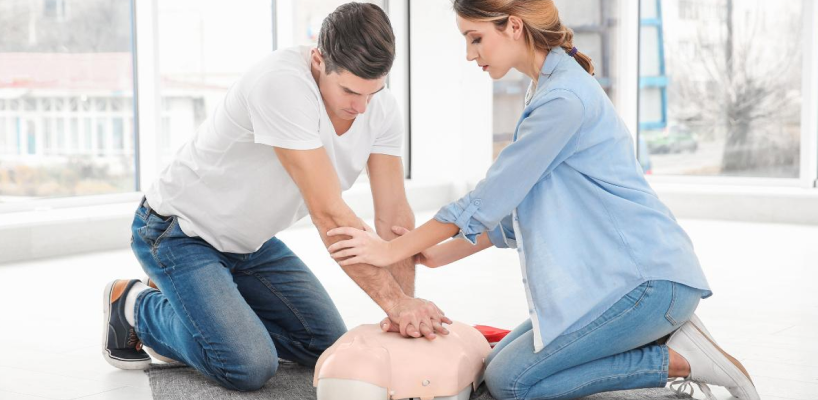
- Last Updated On: June 20, 2024
How to prepare for a CPR certification exam?
Nearly 70% of out-of-hospital cardiac arrests happen in homes. Being equipped with cardiopulmonary resuscitation skills can significantly increase survival chances in critical moments. On your journey towards CPR certification, it is crucial to prepare effectively for the exam.
This vital certification empowers you to respond confidently during emergencies and can also double or triple survival rates. Let us navigate the steps to prepare for a CPR certification exam.
What are the key CPR techniques to master?
Mastering CPR techniques involves effective and prompt cardiopulmonary resuscitation. The process is extensive and involves a set of skills to respond confidently during cardiac arrests. Let us delve into the critical CPR techniques to master while preparing:
- Recognition of Cardiac Arrest: Identifying cardiac arrest is the first stage of CPR. It includes assessing the victim’s level of responsiveness, checking for normal breathing, and activating emergency medical services (EMS) when suspecting cardiac arrest.
- Effective Chest Compressions: Appropriate chest compressions are important for pumping oxygenated blood to vital parts of the body. Make sure you place your hands correctly in the middle of your chest, compressing them not less than 2 inches deep, and set a speed rate between 100 and 120 pumps per minute.
- Rescue Breaths: Rescue breaths help oxygenate the victim’s lungs. Perform 30 chest compressions and then administer two rescue breaths while making sure that you have an adequate seal over the victim’s mouth and nose. Each breath should take about a second, and there will be a visible rise in the chest.
- AED Operation: Automated External Defibrillators (AEDs) make a significant contribution to the restoration of normal heart rhythm. Learn how to put AEDs in by following the visual and auditory signals, putting pads in the proper place, and ensuring everyone is free when shocking.
- Recovery Position: In the case of successful CPR, putting the victim in a recovery position allows for an open airway and promotes breathing. Turn the person gently on his or her side, supporting their head and neck. Observe their condition until professional help comes.
Read More: Get CPR Certified for Free
How to prepare for a CPR certification exam?
Preparing for a CPR certification exam is crucial to acquiring the necessary life-saving skills. This certification enhances your ability to provide swift and prompt medical assistance during cardiac emergencies. The right preparation steps are key to a successful examination. Here are steps to prepare for a CPR certification exam:
- Understand Exam Requirements: Start by getting acquainted with the particulars of a given CPR certification test, such as what will be on it content-wise, how that is formulated, and whether or not there are any prerequisites to knowing, for instance. This basic step enables you to design your study plan accordingly.
- Review CPR Guidelines and Protocols: Dive into the recent CPR guidelines and protocols established by reputable organizations. Ensure a full understanding of techniques and update any changes to protocols aligned with current best practices.
- Engage in hands-on practice: To master CPR techniques, they must have practical application. Train the chest compressions, rescue breaths, and AED operations on mannequins often to form muscle memory while still refining your acquired skills. This is a hands-on approach that makes you confident and proficient.
- Seek professional training or courses: Join CPR training courses or consult certified instructors. Professional training offers structured learning, live feedback, and chances for clarification, allowing for the overcoming of uncertainties regarding the components examined in the exam.
- Utilize study materials and resources: Utilize credible study materials that include CPR manuals, online sources, and practice exams. Reviewing materials regularly ensures that one has retained them and mastered the concepts considered to be fundamental.
What questions are commonly asked in a CPR test?
CPR test questions usually include a combination of theoretical knowledge and practical skills assessments. These can vary depending on the specific certification provider; however, they involve the common topics mentioned below:
Theoretical Knowledge:
Which steps are crucial in the chain of survival?
What are the signs and symptoms of cardiac arrest?
Explain the correct ratio of chest compressions to rescue breaths in CPR.
Define the significance of immediate defibrillation and demonstrate how to apply an AED.
Practical Skills Assessment:
Demonstrate the right position of hands and technique for chest compressions.
How to perform rescue breaths and ensure proper airway management.
Show proficiency in using an AED, including pad placement and procedure.
Deal properly with various situations, like when a choking victim is conscious or unresponsive.
Scenario-Based Questions:
How would you handle a situation where a person is unconscious and not breathing?
If an AED were available at the scene, what steps would you take?
What adjustments do you make to CPR techniques for infants or children?
Explain what you would do in a drowning or near-drowning scenario.
Conclusion
Prepare for a CPR certification exam with a strategic blend of theoretical understanding and hands-on practice. By understanding exam requirements and seeking professional training, individuals can enhance their readiness to respond promptly in critical






